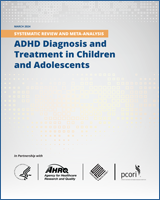From: 4, Results: Diagnosis of ADHD

NCBI Bookshelf. A service of the National Library of Medicine, National Institutes of Health.
| KQ1 Diagnostic Test | Outcome | Number of Studies and IDs | Findings | Reasons for Downgrading | SoE |
|---|---|---|---|---|---|
| KQ1 Clinician tool | Sensitivity | 14 studies27, 121, 167, 181, 298, 299, 355, 388, 400, 403, 407, 416, 417, 434 |
Sensitivity ranged from 25 (corresponding specificity 94%) using actigraph measures taken during CPT task417 to 100% (corresponding specificity 99%) using extended activity measurement355 differentiating ADHD and neurotypical development Sensitivity ranged from 63% (corresponding specificity 74%) using a combination of medical record indicators434 to 93% using smart chair data181 in a clinical sample | C, I | Low |
| KQ1 Clinician tool | Specificity | 14 studies27, 121, 167, 181, 298, 299, 355, 388, 400, 403, 407, 416, 417, 434 |
Specificity ranged from 79% using an observational assessment tool (corresponding sensitivity 87%)167 to 100% (corresponding sensitivity 98%)121 using activity measures differentiating ADHD and neurotypical development Specificity ranged from 36% using interview notes and family history data (corresponding sensitivity 89%)434 to 95% (corresponding sensitivity 67%)181 using smart chair data in a clinical sample | C, I | Low |
| KQ1 Clinician tool | Accuracy | 12 studies27, 121, 181, 298, 299, 355, 388, 403, 407, 416, 434, 437 |
Accuracy ranged from 0.68437 to 0.99121 using activity measures to differentiate ADHD and neurotypical development Accuracy ranged from 0.61 for individual clinical impressions27 to 0.92 using smart chair data181 in a clinical sample | S, I | Low |
| KQ1 Clinician tool | AUC | 12 studies121, 167, 181, 311, 355, 385, 389, 400, 407, 416, 434, 627 |
Activity measures ranged from AUC 0.79627 to 0.9996355 differentiating ADHD and neurotypical development AUC ranged from 0.66 using a combination of medical record indicators434 to 0.98 using smart chair data in a clinical sample | S, I | Low |
| KQ1 Clinician tools | Rater agreement | 2 studies167, 499 |
ICC was 0.92 for raters using the DB-DOS167 differentiating ADHD and neurotypical development Kappa between a clinician interviewer and clinician observing the interview was 0.46499 in a clinical sample | C | Low |
| KQ1 Clinician tools | Internal consistency | 2 studies167, 385 |
Cronbach’s alpha was 0.82 for the DB-DOS167 differentiating ADHD and neurotypical development Cronbach’s alpha was 0.86 for the HDS385 in a clinical sample | C | Low |
| KQ1 Clinician tools | Test-retest reliability | 1 study167 | Test-retest reliability was ICC 0.64 for the DB-DOS167 differentiating ADHD and neurotypical development | C | Insufficient |
| KQ1 Clinician tools | Misdiagnosis impact | 0 studies | No data | C | Insufficient |
| KQ1 Clinician tools | Costs | 0 studies | No data | C | Insufficient |
Notes: ADHD = attention deficit hyperactivity disorder, AUC = area under the curve, C = inconsistency, DB-DOS = Disruptive Behavior Diagnostic Observation Schedule, HDS= InterRAI child and Youth Mental Health Hyperactive/Distraction scale, I = imprecision, KQ = Key Question, S = study limitation; SoE = strength of evidence
From: 4, Results: Diagnosis of ADHD

NCBI Bookshelf. A service of the National Library of Medicine, National Institutes of Health.